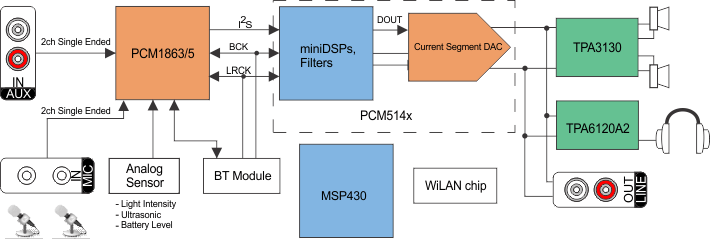ZHCS234B August 2012 – January 2016 PCM5141 , PCM5142
PRODUCTION DATA.
- 1 特性
- 2 应用
- 3 说明
- 4 修订历史记录
- 5 Device Comparison
- 6 Pin Configuration and Functions
-
7 Specifications
- 7.1 Absolute Maximum Ratings
- 7.2 ESD Ratings
- 7.3 Recommended Operating Conditions
- 7.4 Thermal Information
- 7.5 Electrical Characteristics
- 7.6 Timing Requirements: SCK Input
- 7.7 Timing Requirements: PCM Audio Data
- 7.8 Timing Requirements: I2S Master
- 7.9 Timing Requirements: XSMT
- 7.10 Switching Characteristics
- 7.11 Typical Characteristics
-
8 Detailed Description
- 8.1 Overview
- 8.2 Functional Block Diagram
- 8.3
Feature Description
- 8.3.1 Terminology
- 8.3.2 Audio Data Interface
- 8.3.3 XSMT Pin (Soft Mute / Soft Un-Mute)
- 8.3.4 Audio Processing
- 8.3.5 DAC Outputs
- 8.3.6
Reset and System Clock Functions
- 8.3.6.1 Clocking Overview
- 8.3.6.2 Clock Slave Mode With Master and System Clock (SCK) Input (4 Wire I2S)
- 8.3.6.3 Clock Slave Mode With BCK PLL to Generate Internal Clocks (3-Wire PCM)
- 8.3.6.4 Clock Generation Using the PLL
- 8.3.6.5 PLL Calculation
- 8.3.6.6 Clock Master Mode from Audio Rate Master Clock
- 8.3.6.7 Clock Master from a Non-Audio Rate Master Clock
- 8.4 Device Functional Modes
- 8.5 Programming
- 9 Application and Implementation
- 10Power Supply Recommendations
- 11Layout
- 12Register Maps
- 13器件和文档支持
- 14机械、封装和可订购信息
1 特性
- 可编程 miniDSP
- 市场领先的低带外噪声特性
- 可选数字滤波器延迟与性能
- 无需隔离直流电流的电容器
- 集成的负电荷泵
- 智能静音系统;软斜升或斜降搭配模拟静音,实现 120dB 静音信噪比 (SNR)
- 具有 BCK 基准的集成高性能音频锁相环 (PLL),可在内部生成 SCK
- 接受 16 位、20 位、24 位和 32 位音频数据
- 脉冲编码调制 (PCM) 数据格式:I2S、左对齐、右对齐、时分复用 (TDM)/数字信号处理 (DSP)
- 通用串行接口 (SPI) 或者 I2C 控制
- 软件或者硬件配置
- 当 LRCK 和 BCK 被置为无效时,自动进入省电模式
- 1.8V 或 3.3V 故障安全低电压互补金属氧化物半导体 (LVCMOS) 数字输入
- 单电源供电运行:
3.3V(模拟),1.8V 或 3.3V(数字) - 集成型加电复位
- 小型28-pin TSSOP封装
2 应用
- A/V 接收器
- DVD,BD 播放器
- HDTV 接收器
- 需要 2 VRMS 音频输出的应用
3 说明
PCM514x 器件属于单片 CMOS 集成电路系列,由立体声数模转换器 (DAC) 和采用薄型小外形尺寸 (TSSOP) 封装的附加支持电路组成。PCM514x 使用 TI 最新一代高级分段 DAC 架构米6体育平台手机版_好二三四,可实现出色的动态性能并提升针对时钟抖动的耐受度。
PCM514x 系列器件集成了一个完全可编程的 miniDSP 内核,允许开发人员将滤波器、动态范围控件、定制插值器等各类 功能 集成到相关米6体育平台手机版_好二三四中。
PCM514x 提供 2.1 VRMS 中央接地输出(设计人员无需在输出上连接隔直电容)以及传统意义上与单电源线路驱动器相关的外部静音电路。
集成的线路驱动器支持低至 1kΩ 的负载,允许 PCM514x 驱动多达 10 个并联米6体育平台手机版_好二三四(例如 LCD TV、DVDR 和 AV 接收器),性能优于所有其他基于电荷泵的线路驱动器。
器件上集成的 PLL 免除了对于系统时钟(通常称为主时钟)的需要,从而实现一个 3 线制 I2C 连接并减少了系统电磁干扰 (EMI)。
器件信息
| 器件名称 | 封装 | 封装尺寸(标称值) |
|---|---|---|
| PCM5141 | TSSOP (28) | 9.70mm x 4.40mm |
| PCM5142 |
.
简化系统图
